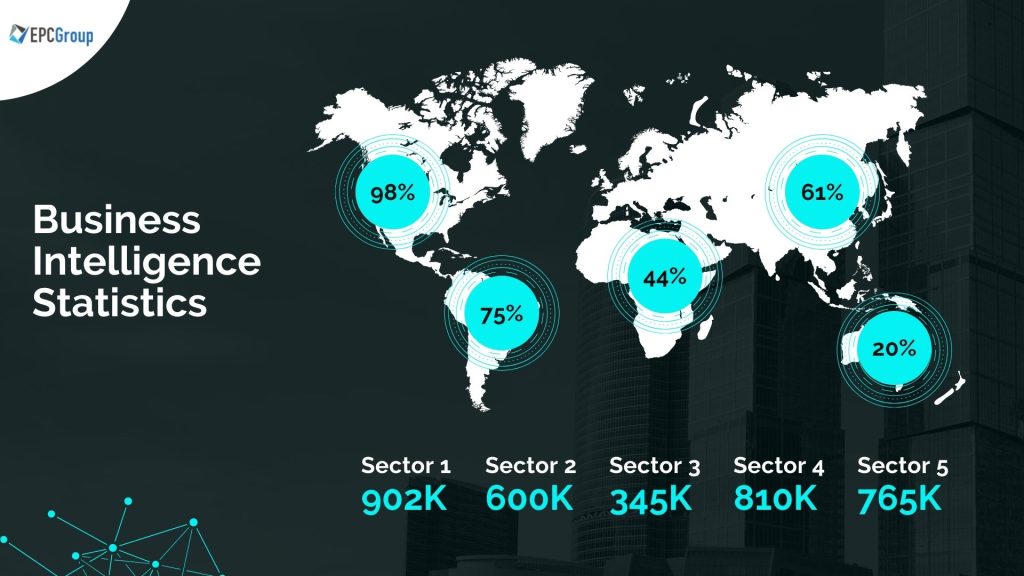Do you notice that the software and processes of your team have changed in the light of the COVID-19 pandemic? Then you’re not alone.
The scramble to go remote has left many organizations patching together different tools and scrapping outdated ones in an effort to keep business moving along. This post is here to answer the questions you have in mind with some statistics and trends for anyone wanting to make enhancements to the way they use technology for work.
You can hardly overestimate the important role of digital technologies in modern corporations’ activities. Most players in different sectors are integrating IT solutions and putting a premium on the digital ecosystem. That trend both makes new challenges and opens up huge development opportunities, changing the established game rules.
The present stage of digital transformation in the economy involves new business models and implements new information technologies.
Digital Transformation Statistics And Trends For 2022
Most talked about Digital Transformation Statistics
1. The pandemic increased the adoption of digital automation technologies.
Source: McKinsey
Eighty-five percent of respondents said their businesses had accelerated the execution of technologies that allow employee collaboration and interaction like filesharing and video conferencing.
2. The pandemic has quickened the development of digital tools by as much as seven years.
Source: McKinsey
For some companies, internal operations and customer interactions have accelerated by three to four years. The share of digitally enabled products has increased by seven years.

3. During the remote work shift, companies moved forty times faster than they thought.
Source: McKinsey
It would take over a year to execute the level of remote working that occurred during the crises. It took eleven days to implement a workable solution, and nearly all the organizations have stood up for workable solutions in just a few months.
4. Companies are planning to invest more in IT for a competitive advantage
Source: Gartner
Worldwide IT spending was projected a total of $3.9 trillion in 2021, an increase of 6.2% from the previous year. That follows a fall of 3.2 percent in 2020.
5. CEOs are focusing more on digital transformation for their companies
Source: Gartner
Twenty percent of CEOs used the word digital, up from seventeen percent in 2020 and fifteen percent in 2019, especially when describing their top strategic business priorities.
6. Culture is just as vital in digital transformation
Source: BCG
In research of forty digital transformations, organizations that focused on culture were five times to accomplish breakthrough performance than those that ignored culture.
7. Digitization of processes will mean a shift in people’s responsibilities and roles
Source: Deloitte
As per this Digital Transformation statistics, Fifty-three percent of respondents said that between half and all of their workforce should revise their capabilities and skills over the next three years.
8. More businesses expect IT budgets to increase over the next twelve months
Source: SWZD
Eighty percent of businesses expect their IT budgets to increase. The way you spend resources on IT might need to change.
9. Ninety percent of new enterprise apps will include AI technology by 2025.
Source: IDC
Together with IoT, AI was one of the fastest-growing technologies in 2021. Researching more about these technologies is an excellent starting point, especially if you’re not certain where to invest your money.
10. Seventy percent of customer interactions will include emerging technologies.
Source: Gartner
These technologies will include mobile messaging, chatbots, and machine learning applications. Your capability to compete is determined by your capability to meet customer expectations.
Digital Transformation failure statistics
11. Forty percent of organizations will not survive in the next ten years.
Source: East Innovations
These companies will not survive if they fail to understand how to transform and change their business to accommodate the newest technologies.
12. Most change initiatives taken up by companies fail.
Source: Harvard Business Review
Sixty to seventy percent of all the change initiatives taken up by organizations fail, according to the data by Harvard Business Review.
13. All change programs fail due to particular reasons.
Source: McKinsey
Seventy percent of all change programs fail because of a lack of support coming from the management and employee resistance.
14. Inability to copy with technology is a major concern to organizational change.
Source: PMI
Fourteen percent of organizational change failures are because of the inability of employees and staff to cope with technology.
15. Improperly defined objectives are another problem.
Source: PMI
Seventeen percent of organizational change failures are because of inappropriately defined goals.
16. Lack of effective communication is another common failure.
Source: PMI
Twenty percent of organizational change failures are because of a lack of efficient communication within the company.
17. Poor project management is another determined problem.
Source: PMI
Thirty-two percent of organizational change failures are because of poor project management skills by the company.
18. Customer value-centric metrics are vital to digital transformation success.
Source: Gartner

According to Gartner Digital Transformation statistics, DevOps and Agile teams focusing on technical performance metrics will be unsuccessful in aligning priorities with the organization.
19. Collaborative work environments as one of the major problems in digital transformation.
Source: PwC
Forty percent list collaborative work environments as a major need that drives HR technology decisions.
20. Workers are concerned about their building management’s skills to enforce safety guidelines.
Source: Honeywell
Forty-nine percent of American workers are worried about their capability to constantly enforce health and safety guidelines.
Digital Transformation as per industry (Healthcare, Technology, Construction, and Retail)
21. The global digital market in the healthcare sector will grow to more than $500 billion.
Source: Statista
It’s anticipated that the global health market is anticipated to grow to over $500 billion by 2025.
22. The use of telehealth increased after the pandemic.
Source: McKinsey
After the coronavirus pandemic in 2020, the use of telehealth services increased from eleven percent to seventy-six percent.
23. The use of augmented reality and virtual reality is anticipated to grow by 2025.
Source: Grand View Research
The global virtual and augmented reality in the healthcare industry is anticipated to reach $5.1 billion by 2025.
24. The overall wearable medical device market is anticipated to increase by 2023.
Source: 360 Market Updates
The worldwide wearable medical device market is expected to reach $27.2 billion by 2023 at a CAGR of twenty-three percent from 2018 to 2023.
25. The worldwide healthcare chatbots market to grow more in 2023.
Source: MarketsandMarkets
The global healthcare chatbots market is expected to reach $314.3 billion by 2023 from $122 million in 2018. How amazing is that?
26. There are more key drivers of digital transformation in retail.
Source: Fujitsu
These key drivers include increased revenue (67%), improved customer service (69%), enhanced efficiency and lowered cost (69%), and competitiveness (70% reporting high or very high importance).
27. Digital transformation in the manufacturing sector to reach $767B in 2026.
Source: Mordor Intelligence
It was valued at $263 billion in 2020 and is anticipated to reach $767 billion by 2026. It works at a growth rate of 19.48 percent over the forecast time of 2021 to 2026.
28. There are more challenges to the retail sector in regard to digital transformation.
Source: Fujitsu
Those challenges involve the complexity of the implementation, with over three quarters rating it as somewhat challenging or highly challenging. Other challenges are upfront costs, availability of talented staff, the time needed to accomplish benefits, privacy and security concerns.

29. Eighty-one percent of enterprises have at least one application in the cloud.
Source: IDG Communications
Thirteen percent with more than 1,000 staff have migrated their IT environment to the cloud.
30. Digital is driving the customer experience.
Source: Fujitsu
Three-quarters of retailers have executed buy online pick up in-store, and seventy-seven percent are seeking real-time in-store suggestions through smartphones.
Digital Transformation growth in 2021 and forecast for growth in 2022
31. Direct digital transformation investment is expected to grow.
Source: IDC
By 2023, it’s anticipated to approach $7 trillion as organizations build on current investments and strategies, becoming digital-at-scale future enterprises.
32. Digital transformation market to grow in 2025.
Source: Research and Markets
The market is expected to increase at a compound annual growth rate of 23% from 2019 to $3.3 trillion by 2025.
33. Securities firms should focus more on globalization.
Source: Wipro
The top opportunity for digital transformation for these companies is growth and globalization from new geographic markets.
34. Leaders are prompted to embrace digital transformation sooner.
Source: Celerity
From the Digital Transformation statistics report from Celerity, Sixty-three percent of leaders mentioned that the pandemic prompted them to adopt digital transformation earlier than initially planned.
35. Devices and enterprise software are the highest growth of digital transformation.
Source: Gartner
These are mainly because of companies seeking to offer advanced workplace solutions.
36. 63% of high-growth corporations have allowed productivity-anywhere workforce models.
Source: Accenture
All that happens with the support of the technology that allows remote work.

37. Firms report forty-five percent of revenue growth.
Source: Deloitte
Companies with advanced digital maturity cited forty-five percent revenue growth that is fifteen percent lower than maturity companies.
38. Global spending on digital transformation has grown.
Source: IDC
Despite the COVID pandemic, worldwide spending on these services and technologies grew ten percent in 2020.
39. More business leaders will leverage digital platforms.
Source: IDC
By 2025, three out of every four business leaders will control digital platforms to adapt to new industries and markets.
40. The global digital transformation to increase to $1.009.8 billion by 2025.
Source: Research&Markets
That’s expected to grow at a CAGR of 16.5% during this period.
Digital Transformation Statistics around profit gained by organizations
41. Organizations noticed increased profits due to digital improvements.
Source: Tech Republic
Fifty-six companies cite those digital innovations and improvements have increased their profits.
42. High-tech B2B organizations reported a cost reduction and revenue growth.
Source: McKinsey
They noticed ten to twenty percent cost reduction and ten to fifteen percent revenue growth from changing their customer experience processes.
43. The revenue for healthcare AI exceeded $34 billion.
Source: BusinessWire
The total revenue opportunity for such a market will go beyond $34 billion by 2025.
44. Companies using big data produce more income than those who do not use it.
Source: BCG
Research by the Boston Consulting Group shows that organizations at the forefront of using big data produced twelve percent more revenue than those companies that do not use big data.
45. Over half of the corporations have completed the digital transformation.
Source: PTC
Over half of fifty-two percent of organizations that go beyond the $1 billion in revenue have finished digital transformation or are currently in process.
46. AI software reviews will reach $100 billion globally.
Source: InformaTech/Omdia
AI software revenues are anticipated to reach $100 billion globally by 2025.
47. Expected ROI is accomplished from companies with an efficient change management program.
Source: McKinsey
One hundred forty-three percent of expected return on investment is accomplished from corporations with an efficient change management program. On the other hand, companies with little or no change management only accomplished thirty-five percent of the anticipated return on investment.
48. Marketers noticed an increase in competition.
Source: Adobe
Sixty percent of marketers mentioned that technology has substantially increased the competition.
49. Companies are increasing their focus on digital transformation.
Source: McKinsey
Among organizations with declining revenues because of the coronavirus pandemic, forty-five percent cited that they are growing their focus on digital transformation.
50. Companies are making new digital business units.
Source: Deloitte
Companies are establishing new digital business units, working separately from their parent companies, to increase their digital revenue.
Conclusion
To wrap it up, Digital Transformation Statistics clearly show us that, the COVID-19 pandemic has spurred the adoption of different digital services, tools, and solutions in organizations across the globe. Thus, it quickens the global transition to the digital economy. Getting senior leaders, strategies, and other important stakeholders on the same page is the key to efficient and flawless digital transformation and implementation.
With the proper digital transformation of various processes and operations comes an important shift in people’s roles and responsibilities. Thus, it is essential to train them and give them proper resources. We hope this article helps you understand and realize the importance of digital transformation in this new reality.
Sources:
McKinsey McKinsey McKinsey Gartner Gartner BCG Deloitte SWZD IDC Gartner East Innovations Harvard Business Review McKinsey PMI PMI PMI PMI Gartner PwC Honeywell Statista McKinsey Grand View Research 360 Market Updates MarketsandMarkets Fujitsu Mordor Intelligence Fujitsu IDG Communications Fujitsu IDC Research and Markets Wipro Celerity Gartner Accenture Deloitte IDC IDC Research&Markets Tech Republic McKinsey BusinessWire BCG PTC InformaTech/Omdia McKinsey Adobe McKinsey Deloitte















